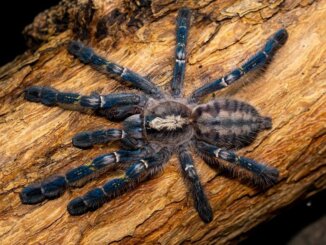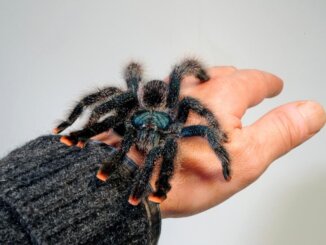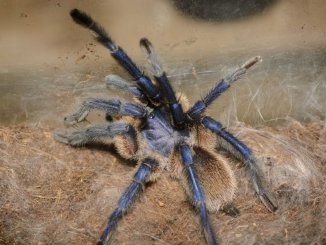The greenbottle blue tarantula is a hairy, colorful spider native to northern Venezuela. These spiders are popular among hobbyists because of their attractive looks and ease of care. However, greenbottle blues are skittish and shouldn’t be handled.
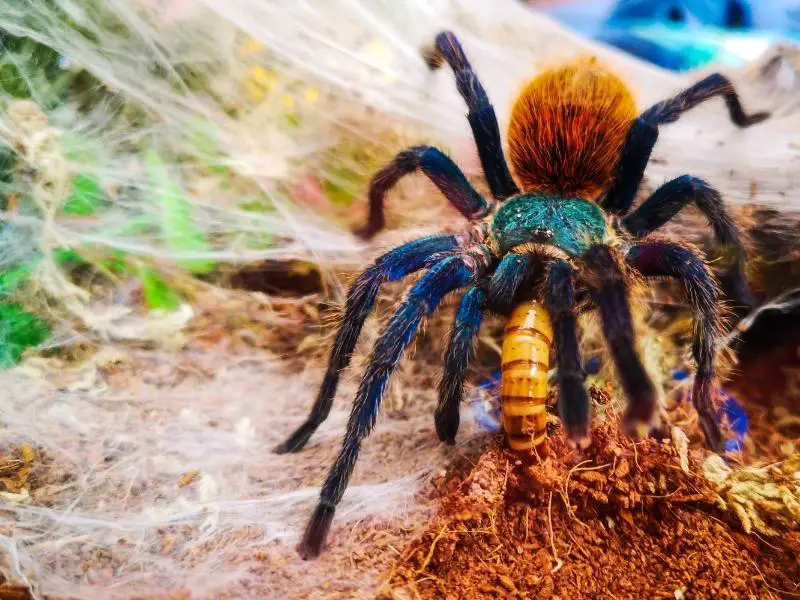
Greenbottle Blue Overview
| Common Name: | Greenbottle blue tarantula, orange bottlebrush tarantula, GBB |
| Scientific Name: | Chromatopelma cyaneopubescens |
| Natural Habitat: | Webbed burrows, grasslands in northern Venezuela |
| Adult Size: | Up to 6 inches |
| Average Lifespan: | Females up to 14 years, males up to 4 years |
| Diet: | Carnivore |
| Housing: | 18-by-12-inch enclosure, 70–78°F, 50%–60% humidity |
| Experience Level: | Beginner |
Origin
The greenbottle blue tarantula (Chromatopelma cyaneopubescens) is native to the Paraguana peninsula in northern Venezuela. Greenbottle blues inhabit webbed burrows in arid deserts and grasslands.
Greenbottle blue tarantulas are prolific in the wild, and are the only species classified under the genus Chromatopelma.
Another common name for this species is orange bottlebrush tarantula, in reference to the spider’s distinctive orange abdomen.
The greenbottle blue tarantula was first classified in 1907 and was originally named Eurypelma cyaneopubescens.
Appearance and Behavior
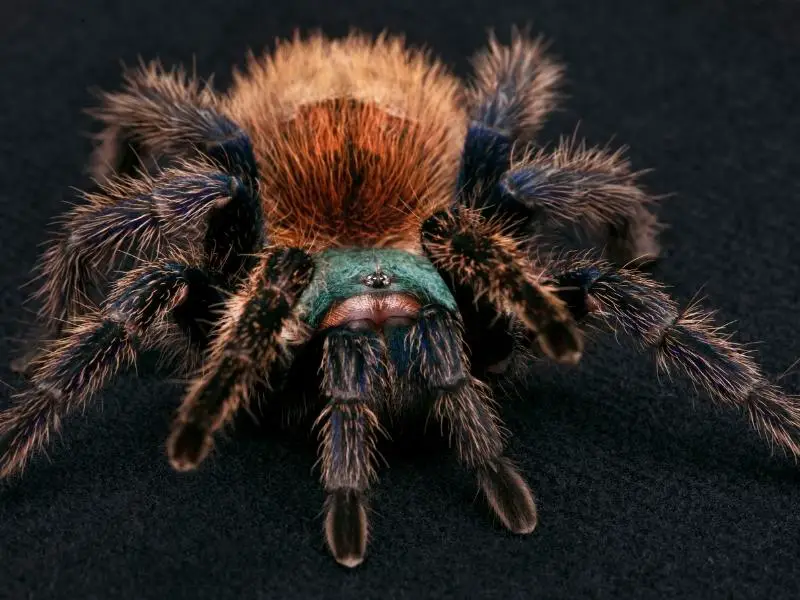
The greenbottle blue tarantula is hairy with vibrant blue legs, a bluish-green carapace, and an orange abdomen. Juvenile greenbottle blues have a dark carapace and pink legs.
Mature males are smaller than females and have tibial hooks — small hooks on the front legs. However, accurate sexing is only possible once the spider is at least 2.5–3 inches in size.
Examining a molt shed is the easiest way to tell male and female greenbottle blues apart. Males have a plain, immovable slit, while females have a spermatheca or “flap,” where the male’s sperm is stored.
Size and Lifespan
Greenbottle blues are medium-sized, with an average body length of 2.75 inches. Females have a diagonal leg span (DSL) up to 6.25 inches, while males have an average DSL of 4.5 inches.
Many female greenbottle blues live for up to 14 years. Males have much shorter lives than females, with a life expectancy of 4 years.
Temperament
The greenbottle blue is active, fast-moving, and docile. Greenbottle blues are venomous, but the venom isn’t dangerous and only causes slight irritation to humans.
Greenbottle blues rarely bite. However, these spiders shouldn’t be handled because they’re skittish and easily stressed. When threatened, greenbottle blues flick their urticating (stinging) hairs or bolt away.
Greenbottle blues shouldn’t be housed together as they exhibit cannibalistic behavior and try to eat one another.
Housing Greenbottle Blues
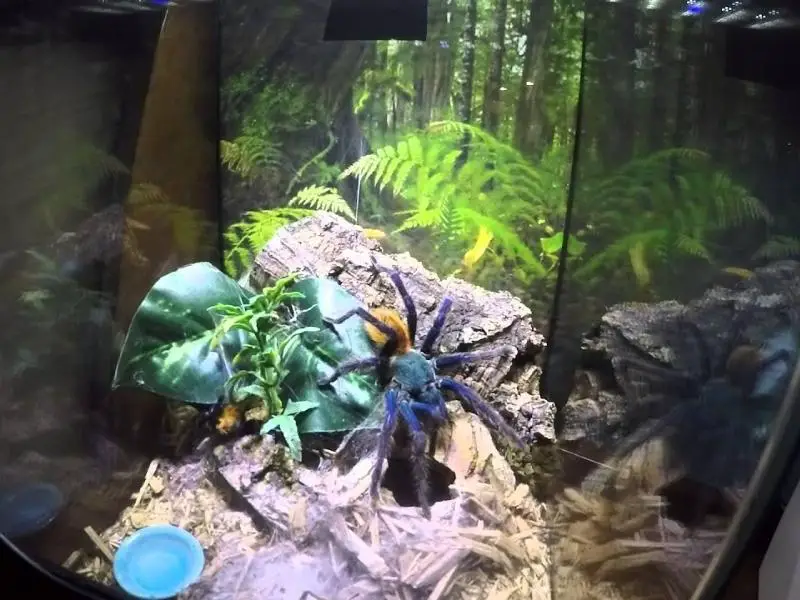
Greenbottle blues are accustomed to arid, shaded, and warm environments in the wild. While hardy, these spiders do best in enclosures that replicate their natural habitat.
Greenbottle blues should be housed in vivariums or tanks. Ensure the enclosure has a secure lid.
Enclosure size
A mature greenbottle blue needs an 18-by-12-inch enclosure or larger. The width should be three times the length of the greenbottle blue’s leg span.
Opt for a vivarium with adequate height — around 18 inches — because greenbottle blues are heavy webbers and burrowers.
The additional height allows room for a thick substrate layer and space for these spiders to make webs.
Lighting
Lighting isn’t necessary. Greenbottle blue tarantulas are sensitive to lighting and do best in dim environments.
Direct, harsh lighting could harm these spiders and affect their resting cycles.
Temperature and Humidity
Greenbottle blue tarantulas are accustomed to temperatures between 70–78°F in the wild. Keeping a similar temperature range in the enclosure ensures the spider is comfortable and won’t overheat.
If the room where the spider is kept is cooler than 70°F, put a heating pad at one side of the enclosure to keep the temperature at a stable and adequate level.
A heating pad creates a thermal gradient (warm areas and cool areas), which helps the greenbottle blue regulate its body temperature. Monitor the temperature daily with a thermometer.
Greenbottle blues thrive in arid environments. Keep the enclosure well-ventilated and at a low humidity. Around 50–60% humidity is ideal. Use a hygrometer to monitor humidity levels.
An enclosure with holes in its sides is best because it allows for more airflow. Misting should be kept to a minimum.
Substrate and Decoration
A deep, 3–4 inch substrate allows greenbottle blues to carry out their natural, burrowing behavior.
Opt for a substrate that is firm, dry, and hasn’t been treated with additives or fertilizers.
Avoid substrates that retain a lot of moisture or contain sharp materials. Good substrate options include vermiculite, fertilizer-free potting soil, sphagnum moss, and coconut fiber.
Greenbottle blues are timid and require plenty of hiding spots to feel safe and at home. Create hiding areas with foliage, caves, cork bark, and plant pots.
Spread hiding spots throughout the enclosure, but ensure there is still enough open space for the greenbottle blue to move around and properly molt.
Provide anchor points for webbing in all areas and at various heights. Create anchor points with vines, branches, cork, and artificial plants.
Artificial plants help replicate the greenbottle blue’s natural habitat.
Avoid heavy decorations like rocks, which compact the substrate and can cause injury if the greenbottle blue tarantula tries to burrow beneath them.
Cleaning
Cleaning the enclosure regularly helps prevent bacteria buildup and keeps greenbottle blues healthy. Spot clean weekly and remove waste daily.
Leftover food should be removed as soon as possible, ideally within a few hours. Use tweezers or tongs when spot cleaning to minimize damage to the greenbottle blue’s webbing.
Note that spot cleaning can cause stress to these skittish spiders. Always wait until the greenbottle blue is settled in a hiding spot before cleaning.
Top up the water dish with fresh water daily.
Deep clean the enclosure every six months or so, which involves cleaning decorations, wiping over the tank’s sides, and replacing the substrate.
The substrate shouldn’t be replaced unless it’s showing signs of mold, general filth, mites, a fungus outbreak, or another issue.
Use a spoon to gently break up and loosen any stuck substrate.
Avoid being rough with the substrate because this can cause urticating hairs trapped in the substrate to come up and sting your skin.
Greenbottle blues should be housed in a separate enclosure while their home enclosure is being deep cleaned.
Set up a secure tank that contains a similar setup to the tarantula’s main enclosure.
Use warm water to clean the enclosure and avoid using harsh chemicals like bleach. Use a soft-bristled brush for extra-tough stains.
Take extra caution when moving the greenbottle blue. Guide the tarantula into a plastic container, and use a piece of cardboard to cover the opening.
Then, release the greenbottle blue into its new enclosure. Remain calm and move slowly.
Greenbottle Blue Care
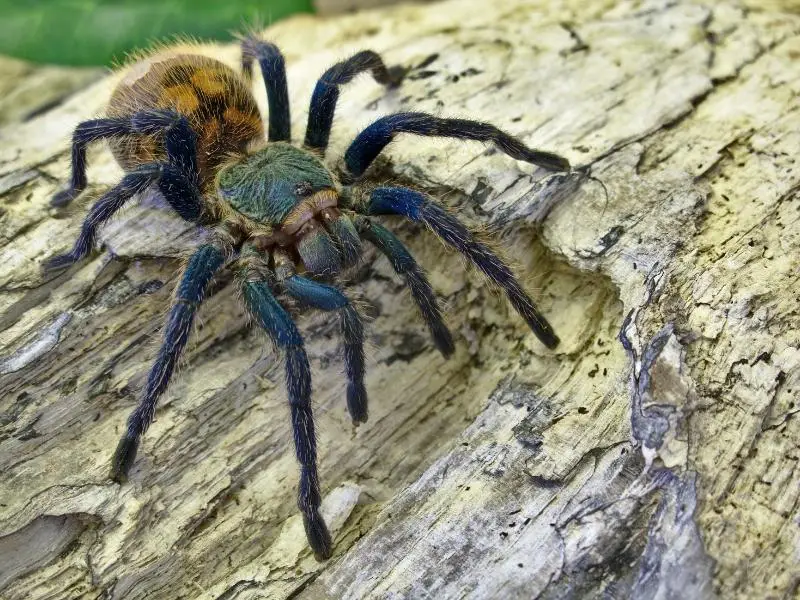
Greenbottle blue tarantulas are easy to care for, making them suitable for beginner hobbyists. These tarantulas require a varied, high-protein diet and an enclosure that replicates their natural habitat.
Food and Water
Greenbottle blues are carnivores. In the wild, these tarantulas eat any prey they can catch within their webs.
Feed greenbottle blues a varied diet consisting mainly of insects. Stick to captive-bred insects, as wild insects can carry harmful pesticides on them.
Good food options include crickets, cockroaches, locusts, beetles, and mealworms. Adult greenbottle blues should be fed once or twice a week. Ensure food is size appropriate — prey shouldn’t be larger than the spider’s abdomen.
Juvenile greenbottle blues should be fed daily or once every few days. Gradually move juveniles onto larger food as they grow.
Hatchling crickets and roach nymphs are great foods for juvenile greenbottle blues because they’re small and highly nutritious. An alternative option is to cut up large prey into tiny pieces.
Greenbottle blues rarely eat when they’re molting, so cut back on feeding during this time. Remove leftovers within a few hours to prevent the enclosure from becoming dirty.
A shallow water dish keeps greenbottle blue tarantulas hydrated. Don’t overfill the water dish, as water affects the humidity level. Also, young tarantulas can easily drown in deep water.
Molting
Mature greenbottle blue tarantulas molt twice to three times a year. Juvenile greenbottle blues molt to grow and can molt as frequently as once a month.
During molting, greenbottle blues become inactive, won’t eat, and often lie on their backs. Remove the exoskeleton (shell) from the enclosure once the spider has finished molting.
Feed the greenbottle blue tarantula after a week.
Common Health Issues
Greenbottle blues are hardy and aren’t prone to any particular health issue. However, common problems include dehydration, mold, parasites, and injury.
Dehydration
Dehydration is caused by over ventilation, a lack of water, or not enough food. Signs of dehydration include a shrunken abdomen and curled up legs.
Treat dehydration by putting the tarantula into a cup containing a damp paper towel.
Mold and Fungus
Check the tank regularly for signs of mold or a fungus outbreak. Clean affected areas immediately.
Replace the substrate completely if the mold has spread and isn’t isolated to a particular spot.
Prevent mold and fungus by ensuring the enclosure is well-ventilated and dry. If left untreated, mold can cause lethal internal organ infections.
Infected greenbottle blue tarantulas develop a white spot on their carapace, abdomen, or legs.
Nematodes
Nematodes are internal parasites that can make greenbottle blues sick.
Symptoms include a loss of appetite, changes in activity level, and a white spot around the tarantula’s mouth.
Unfortunately, there’s currently no treatment for nematodes. Keeping the enclosure clean and well-maintained is the best preventative measure against parasites.
Injury
Greenbottle blues have delicate exoskeletons and shouldn’t be dropped from a height. Keep the greenbottle blue’s enclosure near ground level and invest in a secure lid.
Breeding
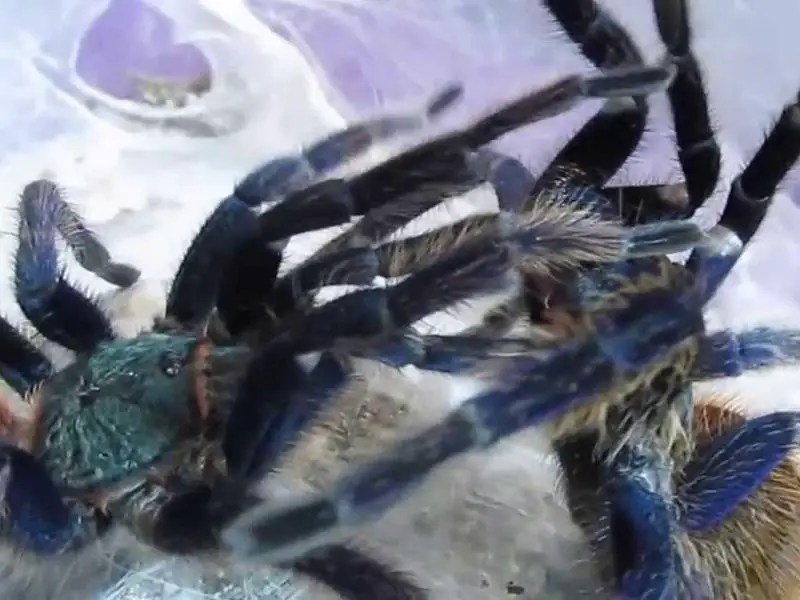
Breeding greenbottle blue tarantulas is difficult. Females are aggressive and often attack and eat males.
Here are the steps to follow when breeding a pair of greenbottle blues:
- Create several hiding spots in the enclosure for the male to retreat to
- Lightly mist the enclosure twice a week for two weeks to raise the humidity
- Feed the female a protein-rich meal once a day for a week before introducing the male
- Carefully put the male inside the female’s enclosure. Ensure the male is some distance away from the female
- Monitor behavior carefully. The male presents himself and taps at the female. A receptive female drums and tolerates the male’s presence. The mating process can take a few hours
- Once the mating process is over, the male should be removed immediately. Otherwise, the female will attack the male
- Female greenbottle blue tarantulas lay up to 100 eggs, and a sac protects the eggs. The incubation period is between 6 to 8 weeks. Hatchlings are visible after 10 weeks
If the female isn’t receptive she will exhibit sudden, jerking movements and try to attack the male. In this case, quickly remove the male with tongs to stop him from being attacked and eaten.
Make sure to separate any spiderlings from the female.
Choosing and Buying a Greenbottle Blue
Greenbottle blues are readily available in online stores, exotic pet stores, and at expos. A greenbottle blue tarantula costs between $80 to $200, depending on the spider’s sex and age.
Buying from reputable breeders ensures greenbottle blues have been raised in healthy conditions.
Avoid buying greenbottle blues that are lethargic, have shrunken abdomens, or exhibit unusual movements.

